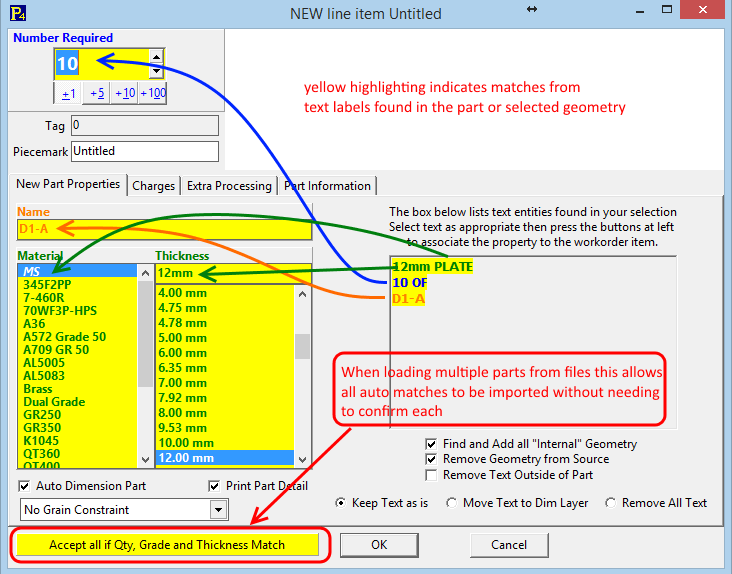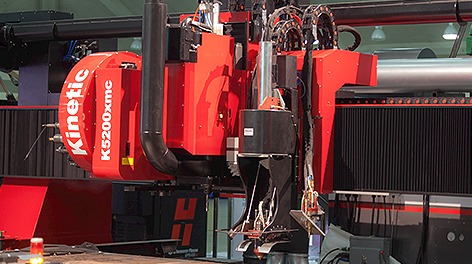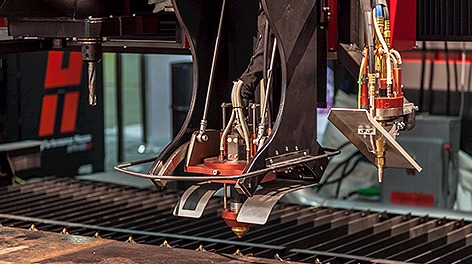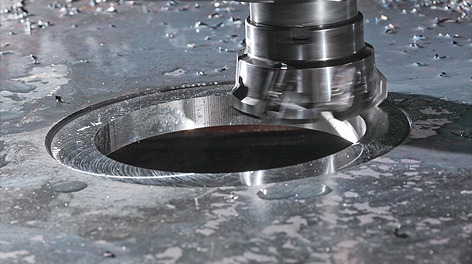PART HARVESTING
PART HARVESTING FROM COMPOSITE DRAWINGS
This refers to the process of extracting individual parts from a composite parts drawings, usually DXF or DWG. There is no general standard as to how these “composite” drawings are defined, so a number of options have been provided.
AUTOMATIC PART HARVESTING
The geometry editor has a new button in the left hand column called Part Harvesting, which initiates a process where Primecut will scan a compound drawing looking for individual parts to split out and add as separate workorder or quote line items.
In doing this Primecut must:
- Recognize individual profile geometry
- Recognize and gather possible additional geometries (such as folding drawings, dimensions etc)
- Gather all related text labels and their text
- Recognize from the gathered text the Quantity Required
- Recognize from the gathered text the Material and Thickness
- Recognize from the gathered text the part name
For a profile to be auto harvested from a drawing all of quantity, material, thickness and part name must be determined. If any are not, the profile will be skipped. The user can then select the remaining profiles and manually create items using the old (but improved) Create Line Item From Function (Ctrl-Alt-P).
Some options are provided to control how the auto harvest is to be performed:
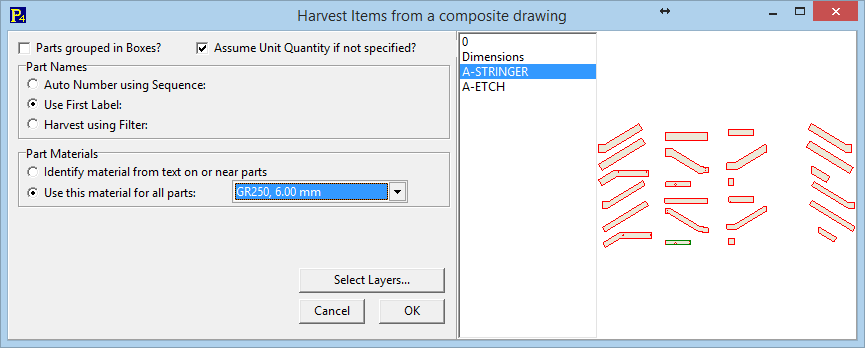
Most of the options are described below, however a couple are worth mentioning here:
- Parts Grouped in Boxes
If the composite drawing has grouping boxes drawn around the parts this should be ticked. If ticked ONLY parts within boxes will be harvested. each part can be within its own box, or the parts may be grouped in multiple boxes, or all the parts may be together in a single box. The boxes help separate parts from each other. - Select Layers
Clicking this allows you to select which layers contain the profile geometry, see below. The image above shows the dialog after Select Layers has been clicked.
PROFILE RECOGNITION (STEP 1)
At step 1, closed paths are identified as being possible profiles. A layer filter can also be applied specifying which layers the profiles are in thus excluding other manufacturing drawings which may be present from the item list. By default the layer filter is set to include all processable, visible layers. ie if additional manufacturing sketches, isometric views etc are put into non-processable layers they will not be recognized as profiles but can still be imported into the nearest profile as additional manufacturing information.
GATHERING OTHER ADJACENT GEOMETRY AND TEXT (STEPS 2,3)
In gathering additional geometry and labels (steps 2 and 3 above), proximity is the sole criterion. ie if a label or text item is closer to a profile than to any other profile, it will be associated with it and gathered intio the same line item drawing.
RECOGNIZING QUANTITY (STEP 4)
The following lines of text will all result in a quantity of 7 being applied, as well as any case variations of these (ie “quantity” = “QUANTITY”):
7 of
7 off
7 Reqd
7 Rqd
7 required
qty7
Qty 7
Qty-7
Qty – 7
Qty : 7
Quantity 7
Quantity – 7
Quantity : 7
The following are also recognized in version 4.5.357 on:
7x
7 x
x7
x 7
Bracketed versions are also recognized, eg “(7 of)”. Recognition is NOT case sensitive so for example qty, QTY and Qty all work.
- To prevent false positives:
The quantity number will not be recognized if it contains a decimal point. - To prevent ambiguity:
The quantity will not be recognized if more than one valid quantity specifier is found. An example we have seen which prompted this behavior is as follows:
Part ABC
Mild Steel 10mm
cut 1 off LH
cut 1 off RH
In this example, there are in fact two parts to be cut. Seeing multiple quantity specifiers we actively fail to recognize quantity, and so will not automatically harvest this part, leaving it up to the programmer whether to create a single line item with quantity 2 or whether he needs to create two mirrored versions of this item.
There is also an option to assume unit quantity if no quantity specifier is found (Assume Unit Quantity…). In an multiple match case as above the unit quantity will not be applied and regardless and the part will still not be auto harvested.
RECOGNIZING MATERIAL AND THICKNESS (STEP 5)
Material and Thickness is recognized. Material and thickness should be adjacent to each other, and matyerial can be an alias for a database material. See Material Aliases.
RECOGNIZING PART NAME (STEP 6)
There are three options for recognizing or otherwise setting an automatic part name:
- Auto Number Using a Sequence: No recognition is performed, instead the parts are simply named sequentially using a format string, where the part number is substituted for %d. Some examples follow:ITEM %d results in ITEM 1, ITEM 2 etc
3259-A-%d results in 3259-A-1, 3259-A-2 etc
3259-A results in 3259-A, 3259-A iie all parts named the same (database settings must allow duplicate part names for this to be effective) - Use First Label: After Quantity and material thickness have been recognized, the part name will be set to the first remaining non blank text found, this suits simple well drawn compound drawings where the text is composed of ONLY quantity, material, thickness and part name.
- Harvest Using Filter: This is a more advanced feature that allows the user to specify the expected format of the part name by means of a regular expression. The regular expression will return the match found within simple parentheses. The matching names will by highlighted in the drawing as the regular expression is modified, and the harvested names and their count will be shown. The ? button takes you to a website where you can experiment with, test and learn about regular expressions. They are powerful but can be somewhat complex. Primecut remembers for each user the last 30 harvest filters applied.
If more than one match is found for a part when harvesting, no name will be matched.
REGULAR EXPRESSION MATCHING FOR PART NAME EXAMPLES
(\bITEM ?[\-: ]? ?[w]+)
This matches any of the following:
Item 123
ITEM : 123
Item A2
Item-1
([A-Za-z0-9]+-[A-Za-z0-9]+)
This matches any of the following:
A-1
AB-123
123-ABC
This does not match:
A – 1
A -1
A- 1
CREATE ITEM FROM ENHANCEMENTS
The new line item window will now automatically recognize as much as it can of quantity, material, thickness and part name, when loading a part from a dwg/dxf or whan using the Create Item From (Ctrl-Alt-P) function in the geometry editor.
When using Create Item From the name match here is simply done using any remaining text left after quantity, material and thickness matches have been removed, when loading parts from file the name is of course the filename as it has always been.
The matches are highlighted in yellow and indicated color-coded in the harvested text section, for example applying Ctrl-Alt-P to the following selection.
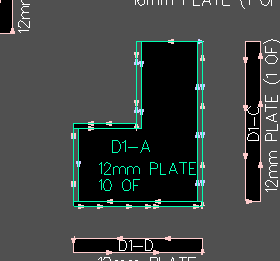
This results in a new line item window with everything matched as follows:
